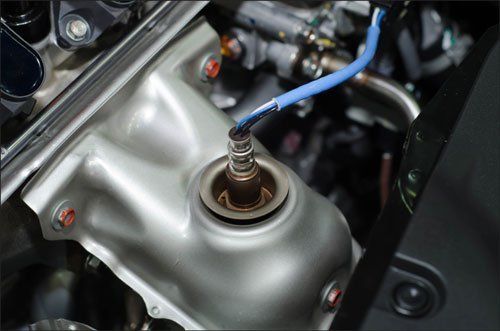Faster Delivery in 3-5 Days
Faster Delivery in 3-5 Days

Modern vehicles are equipped with a wide array of sensors and electronic systems to keep everything running smoothly. One of the most critical yet often overlooked components is the oxygen sensor (O2 sensor). Though small, it plays a huge role in engine performance, fuel efficiency, and emissions control.
In this article, we’ll explain what the oxygen sensor does, how it works, the warning signs of failure, and most importantly — how you can use Autel diagnostic scanners to detect and resolve O2 sensor issues before they become serious.
An oxygen sensor is located in the exhaust system and is responsible for measuring the amount of oxygen present in the exhaust gases. This information helps your car's Engine Control Unit (ECU) fine-tune the air-fuel mixture to ensure optimal combustion.

The location and appearance of oxygen sensors in cars
For gasoline engines, the ideal ratio is 14.7 parts air to 1 part fuel. A faulty oxygen sensor can disrupt this balance, leading to poor fuel economy, increased emissions, and even engine damage.
The sensor compares the oxygen levels in your exhaust gases with those in the outside air. Once it reaches about 350°C, it begins producing voltage signals based on the lambda (λ) value — a key metric that indicates whether the mixture is lean or rich.
If the O2 level in the exhaust exceeds 3%, the mixture is too lean, resulting in reduced power or potential engine damage. If it's lower than 3%, the mixture is too rich, leading to excessive fuel use and black smoke emissions.

An oxygen sensor measures exhaust gases to adjust the engine's air-fuel ratio.
Autel diagnostic scanners like the MaxiSys Elite II Pro, MS906 Pro, or MK900BT allow you to quickly and accurately test the oxygen sensor and identify any issues by accessing real-time data, live voltage waveforms, and fault codes.
Here are the top 5 signs your oxygen sensor may be failing — and how Autel tools can help:
One of the most immediate and noticeable signs of an oxygen sensor issue is the check engine light (CEL) turning on. While this light can signal a wide range of engine and emission-related problems, a failing O2 sensor is among the most common causes.
Autel Scanners Advantage: One-tap scanning, detailed code definitions, and sensor waveform graphs.

The check engine light is on
Has your vehicle's fuel efficiency suddenly dropped? This could be a sign of a malfunctioning oxygen sensor, which fails to provide the correct data about the air-fuel mixture to the ECU. When the ECU cannot properly adjust the mixture, the engine may run too rich (too much fuel), wasting gas and increasing emissions.
With Autel tools, you can:
These features allow users to confirm whether abnormal fuel consumption is sensor-related, enabling quick and accurate repairs before unnecessary fuel expenses add up.
The fuel trim data can be read using the Autel OBD II code reader
Black smoke coming from the tailpipe is a clear sign that excess fuel is entering the combustion chamber, often due to inaccurate O2 sensor readings. This “rich” mixture may be caused by a sensor that is stuck or degraded, leading the ECU to overcompensate with more fuel.
Using an Autel diagnostic scanner, you can:
By detecting these issues early, you avoid harmful emissions, excessive carbon buildup, and engine damage.
When the air-fuel ratio is off, combustion becomes inefficient — this often results in poor throttle response, hesitation, or reduced engine power. This is particularly noticeable when accelerating or driving uphill.
Autel scanners help by:
With this data, even non-professionals can determine whether the performance drop is due to sensor failure or a deeper engine issue.
/O2_zirconium_good_2.png)
The O2 sensor waveform shows voltage changes as fuel mix varies
Does your car shake or sputter when starting, especially in cold weather? A faulty O2 sensor can cause unstable combustion during startup because it sends incorrect oxygen readings to the ECU, preventing proper air-fuel calibration.
Autel scanners allow you to:
With this data, even non-professionals can determine whether the performance drop is due to sensor failure or a deeper engine issue.
Autel diagnostic tools don’t just read codes—they give you the full picture. Whether you’re a DIYer or a professional mechanic, you can:
Your oxygen sensor is a silent guardian of fuel economy, emissions, and engine health. If it fails, it can lead to costly repairs and reduced performance. The good news? With Autel’s professional-grade diagnostic scanners, identifying and fixing the problem is easier and faster than ever.
To learn more about Autel tools or to shop for a scanner that suits your needs, visit our store: obdprice.com